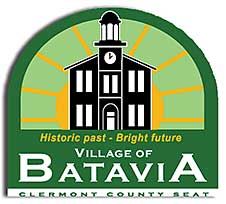Jeff Traylor’s book, Ohio Pride, A Guide to Ohio Roadside History, points out nine communities in Clermont County designated by a state historical marker.
Batavia: “Headquarters of the Batavia Gold Mining Company, 1868”
In the Elk Lick Valley along the East Fork of the Little Miami River, gold was discovered in 1868 by two men who had once been involved in the California Gold Rush of 1849. The ore was discovered on the farm of Robert Wood.
The Batavia Gold Mining Co. was established in 1869 and lasted less than one year because of the small amount of gold to be found in the waters of the area.
Several thousand dollars were spent in establishing the company, organized by Capt. Glass. It was said by several locals at the time that a person could pan for 100 years and maybe collect $2,000 worth of precious metal.
Still, efforts were made to keep the project going until a 200-rod-long flume was washed away, except 16 feet of it, finally discouraging even the most determined of the gold seekers.
One mine was a glacial deposit worked with a flume and the other was a mine shaft located off Cabin Run Creek in an area known as Bear Hollow.
Another “gold rush” took place very briefly in the Stonelick Valley in the 1870s and in the 1930s there was a small “rush” near Owensville. No one was ever reported to have returned home richer for the experience.
Bethel: “Home of U.S. Senator Thomas Morris, Advocate of Human Liberty, 1776-1844.”
Thomas Morris was born in Pennsylvania and moved to Columbia while a young man. From there, he moved to the new county of Clermont and lived at its seat of government, Williamsburg. From there, he moved to Bethel where he lived at the time he was elected United States senator (1833-39).
A Democrat, Morris bucked his party by being one of the leading abolitionists in Ohio.
He was called “The Advocate of Human Liberty” because he led the fight against slavery in the United States Senate.
His position on slavery caused him to lose a chance at re-election when his party refused to support him for a second term.
Morris was not discouraged.
When he returned to Bethel, he continued his fight against slavery and in 1844 ran for vice-president of the United States on the Liberty Party ticket.
His presidential running mate was James G. Birney who, while living in New Richmond, had been the editor of one of the nation’s leading abolitionist newspapers.
While living in Williamsburg, Morris lived on the north side of Broadway Street between Main and Gay streets. While living in Bethel, Morris’ home was on the southeast corner of Plane and Charity streets.
U.S. Rep. Thomas Hamer (Hamersville is named after him) studied law under Morris in the Bethel home, and U.S. Grant’s family lived in the house while he was stationed out west in the 1850s.

